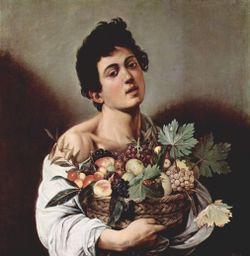
Mario Minniti
Encyclopedia

Italy
Italy , officially the Italian Republic languages]] under the European Charter for Regional or Minority Languages. In each of these, Italy's official name is as follows:;;;;;;;;), is a unitary parliamentary republic in South-Central Europe. To the north it borders France, Switzerland, Austria and...
artist active in Sicily after 1606.
Born in Syracuse
Syracuse, Italy
Syracuse is a historic city in Sicily, the capital of the province of Syracuse. The city is notable for its rich Greek history, culture, amphitheatres, architecture, and as the birthplace of the preeminent mathematician and engineer Archimedes. This 2,700-year-old city played a key role in...
, Sicily, he arrived in Rome
Rome
Rome is the capital of Italy and the country's largest and most populated city and comune, with over 2.7 million residents in . The city is located in the central-western portion of the Italian Peninsula, on the Tiber River within the Lazio region of Italy.Rome's history spans two and a half...
in 1593, where he became the friend, collaborator and model of the key Baroque
Baroque
The Baroque is a period and the style that used exaggerated motion and clear, easily interpreted detail to produce drama, tension, exuberance, and grandeur in sculpture, painting, literature, dance, and music...
painter Michelangelo Merisi da Caravaggio
Caravaggio
Michelangelo Merisi da Caravaggio was an Italian artist active in Rome, Naples, Malta, and Sicily between 1593 and 1610. His paintings, which combine a realistic observation of the human state, both physical and emotional, with a dramatic use of lighting, had a formative influence on the Baroque...
(1571-1610). His main fame today is his identification, or proposed identification, as a model in many of Caravaggio's early works, including Boy with a Basket of Fruit
Boy with a Basket of Fruit (Caravaggio)
Boy with a Basket of Fruit, c.1593, is a painting generally ascribed to Italian Baroque master Michelangelo Merisi da Caravaggio, currently in the Galleria Borghese, Rome....
, The Fortune Teller
The Fortune Teller (Caravaggio)
The Fortune Teller is a painting by Italian Baroque master Michelangelo Merisi da Caravaggio. It exists in two versions, both by Caravaggio, the first from 1594 , the second from 1595...
, The Musicians
The Musicians (Caravaggio)
The Musicians is a painting by the Italian Baroque master Michelangelo Merisi da Caravaggio . It is held in the Metropolitan Museum of Art, New York....
, Boy Bitten by a Lizard
Boy Bitten by a Lizard (Caravaggio)
Boy Bitten by a Lizard is a painting by the Italian Baroque painter Caravaggio. It exists in two versions, both believed to be authentic, one in the Fondazione Roberto Longhi in Florence, the other in the National Gallery, London...
(probable), Bacchus
Bacchus (Caravaggio)
Bacchus is a painting by Italian Baroque master Michelangelo Merisi da Caravaggio . It is held in the Uffizi Gallery, Florence....
, The Lute Player
The Lute Player (Caravaggio)
The Lute Player is a composition by the Italian Baroque master Caravaggio. It exists in three versions, one in the Wildenstein Collection, another in the Hermitage Museum, St...
, The Calling of Saint Matthew, and The Martyrdom of Saint Matthew
The Martyrdom of Saint Matthew (Caravaggio)
The Martyrdom of Saint Matthew is a painting by the Italian master Michelangelo Merisi da Caravaggio. It is located in the Contarelli Chapel of the church of the French congregation San Luigi dei Francesi in Rome, where it hangs opposite The Calling of Saint Matthew and beside the altarpiece The...
.
He ceases to appear as a model after about 1600, when he is believed to have married, but he may have been involved with Caravaggio and others in the 1606 street brawl which resulted in the death of Ranuccio Tomassoni at Caravaggio's hands - his biographer records that he fled to Sicily following a homicide, from where he petitioned for a pardon (it was eventually granted), and it is known that he sheltered Caravaggio on the latter's stay in Sicily in 1608-1609, procuring for him the important commission for the Burial of Saint Lucy
Burial of St. Lucy (Caravaggio)
Burial of Saint Lucy is a painting by the Italian artist Caravaggio. It is located in the church of Santa Lucia alla Badia located on the Piazza Duomo in Syracuse, Sicily....
. In Sicily he established a successful workshop producing religious commissions and eventually became a respected local businessman. Because of the nature of his output, where paintings were produced as a collaborative effort by assistants and pupils, it is frequently difficult to identify exactly which works, or parts of works, are by Minniti's own hand. It is clear that he brought to Sicily the lessons he had learnt from Caravaggio, in particular the use of dramatic chiaroscuro
Chiaroscuro
Chiaroscuro in art is "an Italian term which literally means 'light-dark'. In paintings the description refers to clear tonal contrasts which are often used to suggest the volume and modelling of the subjects depicted"....
and the depiction of scenes seized at the moment of greatest dramatic intensity, but his work (or rather his workshop's output) has been criticised for "endlessly recycled motifs" and "bland religious canvasses". Nevertheless, he is held in high regard in Sicily, and it is possible to speak of a 'School of Minniti' in the island's artistic history.


